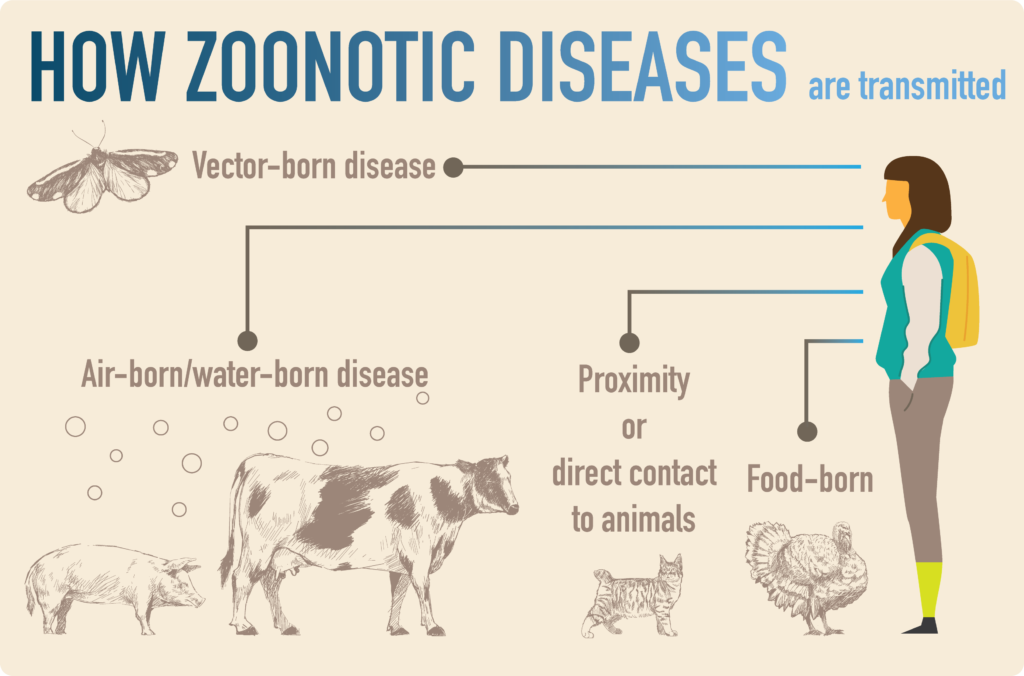Humans have a long history of acquiring infections from animals which are called Zoonotic infections. The diseases transmitted from animals to humans may be bacterial viral, protozoa, or also parasitic. There are over 200 types of zoonosis. It can spread through direct contact or through food, water, or other atmospheric conditions.
Most zoonotic infections are caused by pests. So to maintain a clean and hygienic environment to get rid of the pests that cause dangerous diseases. The World Health Organization (WHO) defines zoonotic diseases as “diseases and infections which are transmitting naturally between vertebrate animals and man”. Direct contact with animals and indirect contact via environment, clothing, and other fomites contaminated by animal secretion also cause infections.
The covid-19 pandemic is just the most recent example in a long list of zoonosis. It comprises a large percentage of new and existing diseases in humans. They represent a major public health issue because we are closer to animals and our environment. With the urbanization of the human population, there is a continuing potential for the origin and spreading of more zoonotic infections from pests.
Types of Zoonotic Infections
Fifty percent of the infectious disease have come under zoonotic diseases. So, it is not a simple problem that we face. The major types of zoonotic infections are,
- Salmonellosis
- West Nile virus
- Plague
- Corona Viruses
- Leptospirosis
- Rabies also
- Cryptococcus
Salmonella
Salmonella is a bacterium that can live in the intestinal tract of many animals. The spread of salmonellosis is primarily through direct or indirect contact with rodents. Common symptoms of salmonellosis are nausea, vomiting, diarrhea, stomach cramps, and also fever.

West Nile Virus
The West Nile disease spreads to people by the bite of an infected mosquito. Most people infected by the West Nile virus do not show any symptoms. Some may develop symptoms like headache, body aches, joint pain, vomiting, diarrhea, also rash.
Plague
The plague bacteria enter the human body through the bite of an infected flea. Major symptoms of plague include fever, headache, chills, weakness, and also painful swollen lymph nodes. If it is not treated immediately, the bacteria will multiply and spread to other parts of the body also.
Coronavirus
Coronavirus disease caused by the SARS-CoV-2 virus causes mild to moderate respiratory illness in people. People with serious infections may need medical attention. The main source of infection is from other infected people.
Leptospirosis
The infection of leptospirosis is with rodents and their environment. Direct or indirect contact with contaminated water is the main source of transmission. Symptoms of leptospirosis include high temperature, headache, nausea, and muscle and also joint pain.
Rabies
Rabies is one of the major dreaded viral diseases found in infected animals like raccoons, skunks, bats, and foxes. If pets come in contact with infected animals, it can be spread through their saliva. Symptoms in humans include fever, headache, sleepiness, or agitation, and may cause death.
Cryptococcus
Cryptococcus fungus is from the bird droppings especially from pigeons and found in soil. People with weak immune systems are at high risk for affecting this. Symptoms of Cryptococcus include shortness of breath, coughing, and also fever.
Causes of zoonotic infections
Zoonotic infections are spread through any contact with domestic, agricultural, or wild animals. The urbanization of places and the destruction of the natural habitat of animals increases the risk of affecting by zoonotic diseases. People living near wilderness and semi-urban areas are also at a high risk of contact with animals.

The common ways of infection are, through ingestion, inhalation, skin contact, and also mucus membrane.
- Ingestion- through eating, drinking, smoking and also nail baiting
- Inhalation- Throughaerosolized agents can enter through inhalation
- Skin contact- infection may be through abrasion or skin wound.
- Mucus membrane- contact with conjunctiva in eyes, or gums and also cheeks inside mouth
Prevention and control of zoonotic infections
The close relation of humans with animals, agriculture, and other environmental practices is the main reason for infection by animals. So, the primary preventative measure is safe and appropriate animal care. It includes maintaining the proper standards for clean drinking water and waste removal, and following behavioral adjustments like practicing handwashing after contact with animals.
In conclusion, the role of pests in spreading zoonotic diseases is not avoidable. So, pest professionals have a major role in protecting others from zoonotic infections. The New Star Pest control in UAE is one of the major pest control providers in Dubai, Abu Dhabi, Ajman, and also in Sharjah.

